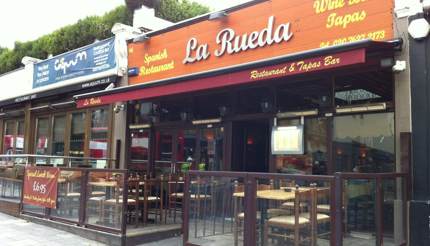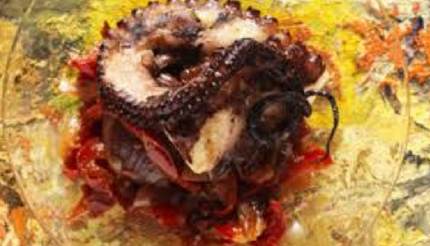From cheap and cheerful to ‘a surfeit of plain deliciousness’, Zoe Williams follows the rise and rise of the small plate
Here follows a complete history of London tapas, arguably the most influential food vogue in restaurant memory, not because we all eat chorizo every day now (although I’d love it if we did), but because of the form.
It arrived years ago as a sort of “remember-that-time-you-went-on-holiday?” scene; cheerful, informal establishments where they sing you happy birthday and smash metal trays on the floor in celebratory fashion.
My favourite was always La Rueda on Clapham High Street, but really it was like choosing a football team. You’d just go to your closest, then claim it was the best.

This is serious food
Two things happened: first, tapas got fancy. Barrafina is the classic “modern” joint, which is the word they use to mean, “this is nothing like being on holiday, this is serious food.” Salt Yard and its sister restaurant, Opera Tavern, arrived, and lo, it was all beautiful in the land of tapas, scallops leapt insistently onto elegant slate plates, drinking sherry became not just normal, but smiled upon.
But really, the point wasn’t the food but the message. Small plates were for people who didn’t want to commit to a big plate. As it turned out, that was almost all of us. Sharing was for people who wanted to escape the tyranny of the impromptu-share, where they give you a great big bite of their boring cod, and then you have to surrender some of your grouse.

Tapas no longer had to be Spanish
So it came to pass that tapas no longer had to be Spanish: it could be Italian – Polpo brought a blast of Venetian joy, with its hazelnuts and radiccio, which has never dispersed. Its sister restaurant, Spuntino, was to all intents and purposes American and I think invented the slider – burger tapas – though this is as debatable as who invented apple pie.
Modern British joints became small-plate by default, which generated some incredible innovation: when your core cuisine is a giant bit of meat, a new technology like “smaller piece of meat” can be quite disruptive. The now-closed Fig, in Barnsbury, a lesser-spotted part of Islington, had the languid, aching charm of the dream you have on the first night of a hot holiday.
The Dairy and its diffusion-joint, the Manor, back in Clapham, took the form to new levels of artfulness – dainty bits of mackerel blow-torched at your table, a millefeuille of crisp chicken skin with BBQ sauce and kimchi, which unlikely sounding dish is still my death row meal, and if they offer me three courses, I’ll have it thrice.

The small-plate rip-off
It was paradise in the land of small plates, and so inevitably arrived the serpent, in the form of the small-plate-rip-off. Its principles were simple: you cut the price of a main by half, and the portion by two-thirds. It became ridiculous. I don’t want to mention names because I’m gracious like that, and if you’ve been paying attention you need never accidentally stumble into one. But I’ve been in places where they laugh in the face of the sharing principle. You can practically hear the sniggering from the kitchen: chicken wings with one wing; heritage carrots sliced like Iberico ham.
Bloggers were much faster to pick up on this than reviewers, owing to the fatal inattention of the person not paying for their own dinner. The youngsters would look at the old-timers and murmur, “small plate mug”, which is English for “that person has just spent £12 on half a beetroot”.
Combined with the brunch tsunami, the net result was that plates, everywhere, got a lot smaller. It got to the ironic point that the only place you could get a portion fit for an adult was from a street food vendor. Feed that back into the fact that the trend had deviated so far from Spain that sushi was selling itself as tapas, and a pall of inauthenticity fell over the whole enterprise, which had started life as boisterous and genuine as seaside rock.
Back to first principles: the distilled essence of tapas
Only a radical return to first principles could bring it back to life, and that’s what’s going on: Paul Belcher originally opened the Donostia Social Club in Brixton Pop, a pop-up of shipping containers that predisposed itself to creativity by not being a proper building and ergo, having low rents. That was for foodies, in the foodie tapas mold.
Yet The Tapas Room, in Broadway Market, Tooting, less established but more sceney than Brixton, is the distilled essence: small, exquisite plates designed solely to accompany drinks. Four different kinds of Vermouth vie with each other to have the most delightful label: Palomino Fino en Rama, a wine made from a sherry grape which will upend all your perceptions of what both those things should taste like, defines this tiny restaurant. Into this cave of high spirits, the food is simple, earthy but imaginative, Manchegan black pudding dotted with a quail’s egg, feisty cheeses and delicate meats.

Granted, it’s not totally authentic: the verb “tapar” means “to cover” – it’s the tiny dish, often a handful of crisps or a cube of tortilla, which you’re given with any drink, anywhere in Spain. Tapas Room tapas come with a price tag; a Manchegan fellow from the 1950s wouldn’t imagine himself back home.
A surfeit of deliciousness
But there is a sense of purpose, a lack of gimmickry, and a surfeit of plain deliciousness that reminds you what the whole thing was originally supposed to be about, while skipping all the rafts of flabby tortilla by which the journey from one coast to another was traditionally made.
It makes you realise how much there is to recommend a simple, pared-down menu, when it is as considered and coherent as this.
Anyway, small plates ain’t goin’ nowhere, but this new purism will run and run.





